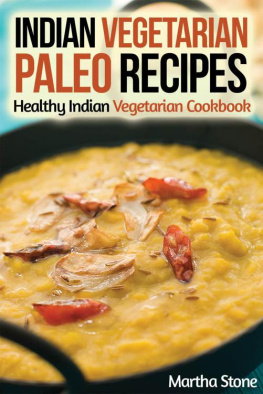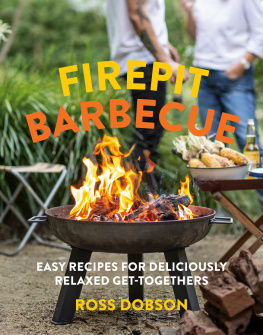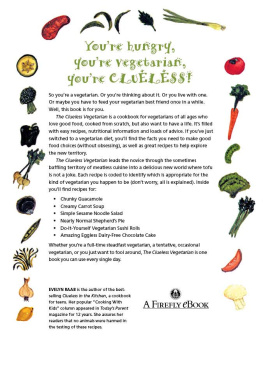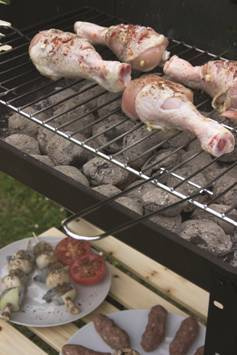INTRODUCTION
When looking for vegetarian recipes for inspiration, you really dont have to search too hard: next time you are at your local South-East Asian, Chinese, Indian, Japanese or Middle Eastern restaurant, have a closer look at the menu. These cultures have long traditions of vegetarianism, so naturally their cuisines are loaded with wonderful vegetarian dishes, featuring ingredients that are now more easily accessible than ever before.
I happen to be Australian, and in Australia we do love our barbecues. And many vegetarian dishes from afar are indeed perfectly suited to barbecuing. But I must be a little careful here, as this is no more an Australian cookbook than it is a cookbook just for vegetarians.
Vegetarian barbecue cookery is not about trying to reinvent the wheel. And good vegetarian cooking is certainly not about a need to make a meat substitute. Some vegetarian dishes stand alone as marvels in their own right. The famous Middle Eastern eggplant (aubergine) dip known as baba ghanoush, for instance, simply cannot be made without a good lick from a naked flame. This purplish black vegetable (well, actually, its a fruit) withstands the searing heat of the barbecue, while the flesh inside cooks to a silky, smoke-infused softness.
Or how about barbecued onion rings, which often start off the barbecue because they take some time to slowly cook to a soft, golden, caramelised sweetness, filling the air with a mouthwatering fug, while also seasoning the hotplate nicely, ready to flavour the next batch of barbecued food. Barbecued onions are good enough to eat on their own, but toss them warm, into a bowl with a twist of lemon juice, some soy sauce and mirin and you have something pretty special without too much effort.
And dont forget the humble potato cooked in its own skin. Large potatoes are best left unpeeled, wrapped in foil and cooked on the barbecue until the flesh inside is pillow soft, ready to be cut open and filled with butter, sour cream or labneh, and finished off with a sprinkling of salt and some soft herbs like parsley, chervil, tarragon or chives.
There is something magically atmospheric about the hiss of food on the barbecue and the irresistible aromas that accompany it. This is quick, simple cooking at its sizzling best.
Take the famous Jemaa el-Fna market, held in a large, medieval square in Marrakesh. By day it is a thriving maze of market goods, selling everything from orange juice to leather backpacks, with snake charmers, charlatans and magicians vying for attention. At night it transforms, in my mind, into the worlds largest barbecue. Hundreds of food stalls are lit up by blurred fairy lights, made even more romantic by the thick shroud of barbecue smoke in the air. So special is this place that it has been proclaimed a UNESCO Masterpiece of the Oral and Intangible Heritage of Humanity.
The Aw Taw Kaw market in Bangkok is similarly famous for its smoking woks and hotplates, sizzling with barbecued treats. Here, the metal skewers of the Middle Eastern kebab give way to bamboo skewers, and I have included plenty of recipes for both styles of kebab in this book.
Tender vine vegetables such as small heirloom tomatoes, zucchini (courgette) and eggplant (aubergine) are naturally skewerable. You can skewer just about any vegetable you like, although do remember to partly cook harder root vegetables beforehand, to give them a chance to cook through. Skewered vegies like big flavours, so alternate them with cubes of firm cheese such as haloumi or Indian paneer. Cook until the cheese is golden and the vegies tender, then finish off with some herbs and a tangy citrus-based dressing.
I use my new barbecue as an oven of sorts. Most modern barbecues have lids and mine, with its stainless steel encasing, conducts and radiates heat really well. When cooking breads, and for nicely charred vegies and cheese, preheat the grill and hotplate burners to high and close the lid. You will see the thermometer rise and the barbecue will then act like an oven. You can sit a cooking rack on the hotplate or grill, keeping food off the direct heat, to make the most perfect and authentic breads; in particular its a great way to cook pocket bread. (The lid of the barbecue, by the way, is also a great spot to prove bread dough.) But dont stress if your barbecue doesnt have a lid an upturned metal mixing bowl will do the same job.
And do use all those inventions of convenience in your kitchen as well. Cook saucy things in little heatproof pots directly on the barbecue. Tear off a sheet of baking paper to cook the food on, especially soft ingredients like tomatoes and cheese your food will still have appetising grill marks, but without the mess, and the corners of the paper can be used to pick up the cooked food and tumble it into a bowl or straight onto a platter. Wrap food in foil or baking paper to make parcels that are steamed within; for an air of added drama, these barbecued parcels can be served and unwrapped at the table.
Choose quality, seasonally fresh ingredients, stick to the classic flavour co mbinations, introduce a variation or two to keep things interesting and you cant go wrong. If you are even remotely familiar with vegetarian cooking, youll know this already. And if not, after tasting some of the recipes in this book, youll hopefully agree that vegetarian cookery definitely deserves a place on the barbecue.
TYPES OF BARBECUES
Compared to other foods, cooking vegetarian recipes on the barbecue involves relatively little mess and little smoke, which offers greater flexibility. Still, when testing the recipes in my barbecue books, I usually do so on my old front verandah, so I can make as much mess and smoke as I need to.
I often find myself developing recipes in winter, and because of deadlines I cant always wait for the sun to shine before I start barbecuing. The great thing about the vegetarian recipes in this book is that in wet or cold weather you can simply cook them inside on an electric grill or hotplate! But this is really defeating the social nature of barbecuing, so Im assuming for this book that you will generally be cooking outdoors.
Here are the main pros and cons for the different contraptions you can use.
ELECTRIC
Electric barbecues offer a mobile and convenient way of cooking, and are ideal for apartment living. Even better if you have a balcony, so you feel like you are barbecuing outdoors. But they do have downsides: electric barbecues and grills often have a built-in thermostat that cuts out the heat, meaning you have less control when cooking. Not ideal when barbecuing.

















